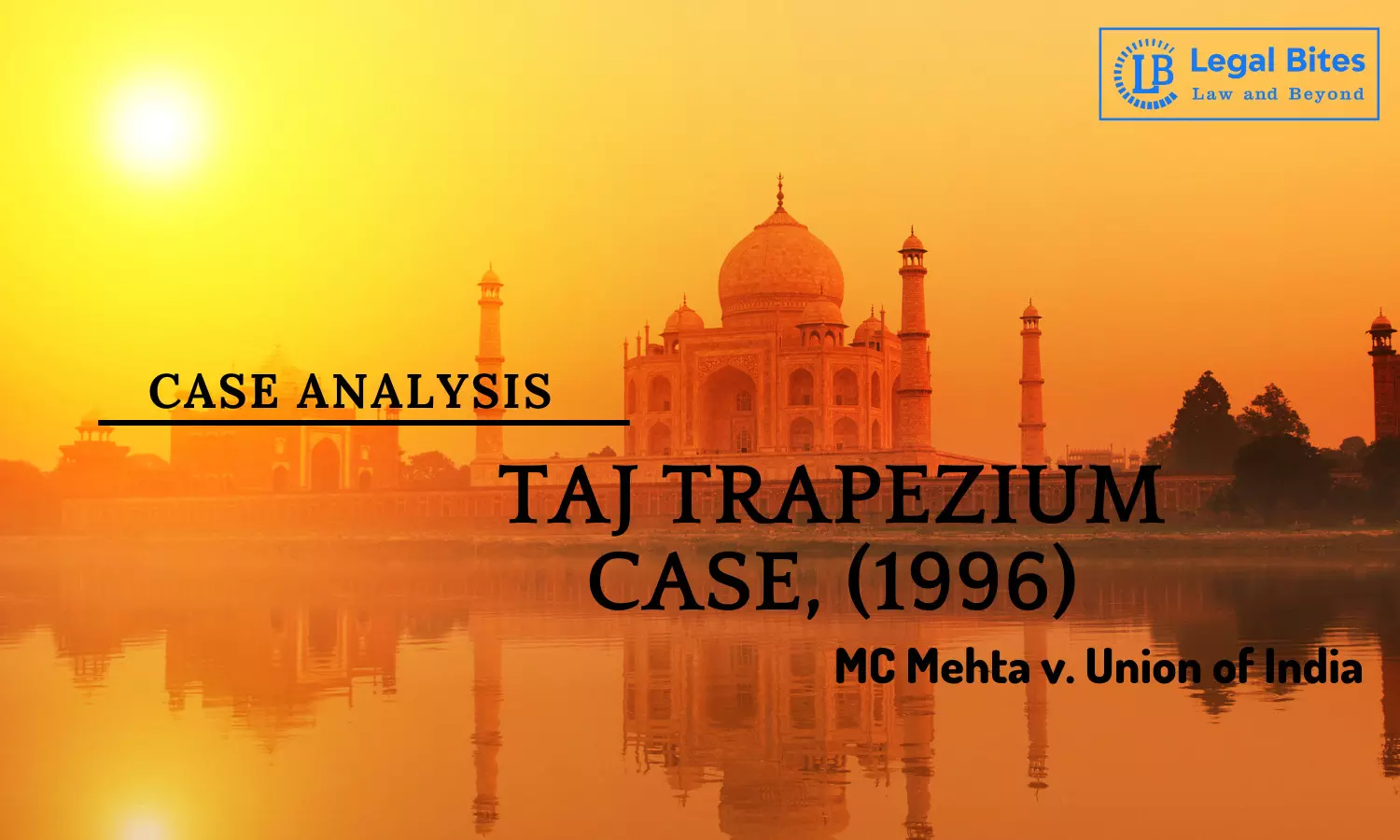Case Analysis: MC Mehta v. Union of India (1996) | Taj Trapezium Case
The Case Analysis: MC Mehta v. Union of India (1996), commonly known as the Taj Trapezium Case, revolves around the protection and preservation of the Taj Mahal, one of India's most iconic monuments.

The Case Analysis: MC Mehta v. Union of India (1996), commonly known as the Taj Trapezium Case, revolves around the protection and preservation of the Taj Mahal, one of India's most iconic monuments.
The case is significant for its emphasis on environmental jurisprudence and the court's intervention to protect a cultural and historical heritage site.
Case Title: MC Mehta v. Union of India
Court: Supreme Court of India
Citation: [1997] 2 SCC 353
Judge: Kuldip Singh (J), Justice Faizan Uddin (J)
Judgment on: 30th December 1996
Introduction
Taj Mahal, one of the seven wonders of the world, is renowned for its originality, exquisite architecture with concave and convex shapes, light-shadowing green walkways, beautiful white marble, and the four minerals that give the frame depth. In 1632 A.D., the Mughal emperor Shah Jahan built it in remembrance of his beloved wife Mumtaz Mahal. Due to the rising pollution levels close to the Taj Mahal, a petition was filed. M.C Mehta might be alluded to as the pioneer of open intrigued cases relating to the environment in India. The 10400 sq. km region around the Taj Mahal is known as the Taj Trapezium Zone (hereinafter referred to as “TTZ”) covering five districts within Agra. The Agra Fort, Taj Mahal and Fatehpur Sikri are all parts of the Agra World Heritage Site.
Background
People are far more aware of the environment now than they were in the past. Numerous international agencies, organisations, and conferences were compelled to establish notions such as public trust doctrine, polluter pays principle, precautionary principle, and sustainable development in response to the environment's rising degradation. Article 48A of the Indian Constitution provides the duty of the State to protect and improve the environment and to safeguard the forests and wildlife To provide a safe environment for the people of India, the Ministry of Environment, Forest and Climate Change was formed in 1985.
Facts
The declining state of the monument led to the submission of the petition. The emissions from adjacent companies and businesses, which included diesel trains and buses, backup generators, and residential fuel consumption, were causing pollution that proved damaging not just to the monument but also to the people around it. The petitioner claimed that the marble's yellow colour was mostly due to pollution. Acid rain is a result of the emission of pollutants such as sulphur dioxide and oxygen, which is bad for the environment and monuments alike. The request was raised for the protection of the Taj Mahal.
Consequently, the Agra-Mathura region's 'Inventory and Assessment of Pollution Emission' was released by the Central Board for the Prevention and Control of Water Pollution. The research identified excessive levels of pollution and suggested ways to lower them. One of the recommendations made in the study was to close the thermal power plants. Reducing sulphur dioxide emissions by 50% was another stage.
As per the petitioner, the most common sources of harm to the Taj Mahal were the foundries, chemical industries, and refineries. With the assistance of dampness within the environment, gases like sulphur dioxide released by such businesses combine with oxygen to create "Acid Rain". This includes a corrosive impact on the Taj Mahal's marble. There's self-evident harm to the marble utilized inside the Taj Mahal. The rising pollution has become a serious issue to protect the Taj Mahal from degradation
Judgment
Judgment was delivered on December 30th, 1996, by a Division Seat comprising Judges Kuldip Singh and Faizan Uddin. By applying the rule of attainable change, the court figured out that the has to be an alteration between common security and budgetary progression. Other than that, the court recognized important principles known as the Polluter Pays Rule, Sustainable development, and the Precautionary Principle.
The Court stated that the polluter has to be held committed to compensate the affected party. The judgment additionally depended greatly upon the diverse reports that came to light. As the court was enormously resolute in the shirking of development debasement and demolition, it asked the neighbouring businesses to either move to natural gas or shut down the operations of such businesses causing pollution that affected the Taj Mahal. The Court recommended that the Gas Authority of India Ltd. (GAIL) shall commence the supply of gas to the industries by June 30, 1997.
The court addressed most common sources of pollution were press foundries, ferroalloy businesses, elastic and lime handling, designing, the chemical industry, brick hard-headed, and automobiles. Central Pollution Control Board was instructed to issue a public notice and distribute the same in two neighbourhood daily papers and two national daily papers as guidelines for the installation of anti-pollution treatment plants. Even though the National Environmental Engineering Research Institute (referred to as “NEERI”) submitted its report on the measures for controlling the outflow of Sulphur dioxide at Mathura Refinery, the Mathura matter was managed independently by the Supreme Court. The report prescribed consideration of made strides Sulphur Recuperation Unit, utilization of common gas, establishment of a hydrocracking unit and giving for a green belt around the refinery.
Conclusion
Pollution is rising quickly everywhere in the world these days. The Taj Mahal is renowned for its beauty and architecture. It aids in taking the initiative to stop monument deterioration. It also aids in the implementation of pollution control measures. The issue of environmental degradation across the Taj Mahal was brought to light by this historic ruling in the Taj Trapezium Case. Not only did it aid in the discovery of some causes for the degradation of the monument's marbling, but it also subtly identified many environmental problems related to it. The Apex Court showed great initiative by carefully considering a variety of environmental law concepts and theories.
Click Here to Read the Official Judgment
Contributions from: Vaishnavi Parate and Apurva Neel
Important Links

